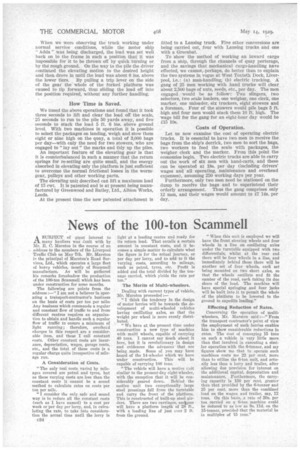News of the 100-ton Scammell
Page 64

If you've noticed an error in this article please click here to report it so we can fix it.
ASUBSECT of great interest to many hauliers was dealt with by Mr. E. C. Marston in the course of an address to the members of the Liverpool Traffic Club on May 7th. Mr. Marston is the principal of Marston's Road Services, Ltd., which operates a large fleet of heavy vehicles, mostly of Scamtnell manufacture. As will be gathered his remarks foreshadow the production of the 100-ton Scainmell which kas been under construction for some months, The following are points from the address :—" I am not a believer in operating a transport-contractor's business on the basis of costs per ton per mile: Any business which commands a regular and constant flow of traffic to and from diEerent centres requires an organization to obtain and handle such a regular flow of traffic to ensure a minimum of light running; therefore, overhecd charges in this respect arc a consider. able item, and these I call constant costs. Other constant costs are insurance, depreciation, wages, garage rents, etc., and the total of these costs is a regular charge quite irrespective of mileage run.
A Consideration of Costs.
"The only real costs varied by mileages covered are petrol and tyres, but as these varying costs are less than the constant costs it cannot be a sound method to calculate rates on costs per ton per mile.
"I consider the only safe and sound way is to reduce all the constant costs (such as I have named) to a cost per week or per day per lorry, and, in calcu• biting the rate, to take into consideration the actual time until the lorry is
c34
light at a loadin'e-, centre and ready for its return load. That entails a certain aniount in constant costs, and it becomes a simple matter to calculate what the figure is for the actual journey, or per day per lorry, and to add to it the varying costs, according to mileage, such as petrol, tyres, etc. Profit is added and the total divided by the tonnage carried, which yields the rate per ton."
The Merits of Multi-wheelers.
Dealing with current types of vehicle, Mr. Marston proceeded :—
" I think the tendency in the design of motor lorries will be towards the development of multi-wheeled vehicles having oscillating axles, so that the weight per wheel is more evenly distributed.
"We have at the present time under construction a new type of machine with multi wheels, capable of carrying 40 tons. I cannot say much about it here, but it is revolutionary in design and evidences the advances that are being made. Some of you may have heard of the 14-wheeler which we have under construction. This will be capable of carrying 100 tons.
"The vehicle will have a motive emit similar to the present-day eight-wheeler, with the exception that it will be considerably geared clown. Behind the motive unit two exceptionally large steel pressings fall from the turntable and carry the front of the platform. This is constructed of built-up steel girders. There are two carriages, nedfgene will have a platform length of 28 ft., with a loading line of just ever 2 ft. from the ground: " When this unit is employed we will have the front steering wheels and four wheels in a line on oscillating axles under the turntable equipped with two differentials, whilst at the rear end there will be four wheels in a line, and immediately behind these there will be another set of four wheels, each set being mounted on two short axles, so that the wheels oscillate and fit the camber of the road, each taking its due share of the load. The machine will have special springing and four jacks will be built into it to permit the whole of the platform to be lowered to the ground to expedite loading."
Effecting Reduction of Rates.
Concerning the operation of multiwheelers, Mr. Marston said :—" From the transport contractor's point of view the employment of such lorries enables him to show considerable reductions in rates. The cost of conveying 15 tons on such a vehicle is very little more than that involved in executing a similar operation with the 6-tonner, and my figures show Inc that to operate such machines costs me 22 per cent, more than to utilize the 6-ton unit, and actually less than a lorry and trailer, after allowing due provision for interest on the additional capital, depreciation and maintenance. Furthermore, the carrying capacity is 150 per cent. greater than that provided by the 6-tonner and 25 per cent, more than the combined load on the wagon and trailer, ,say, 12 tons. On this basis, a rate of 20s. per ton carried on a 6-ton machine could. he /reduced to as low as Ps. 11d, on the 15-tonner, provided that the material be in multiples of 15 tons."




























































































































